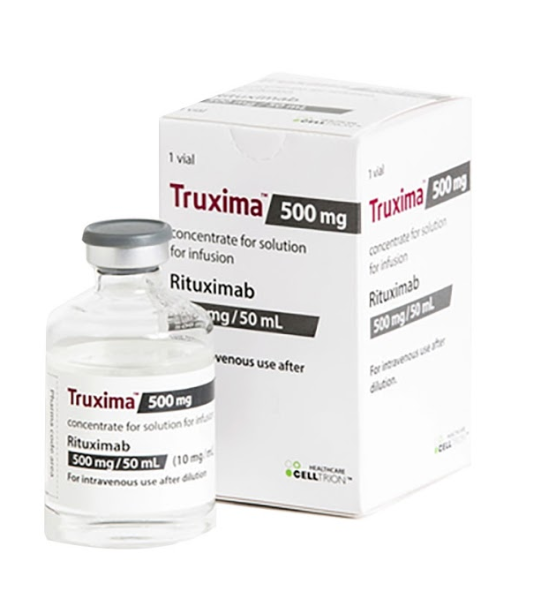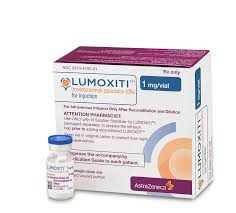Truxima (rituximab) vs Lumoxiti (moxetumomab pasudotox)
Truxima (rituximab) vs Lumoxiti (moxetumomab pasudotox)
Truxima (rituximab) is a monoclonal antibody that targets the CD20 protein found on the surface of B-cells and is commonly used to treat conditions such as non-Hodgkin lymphoma and chronic lymphocytic leukemia, as well as rheumatoid arthritis. Lumoxiti (moxetumomab pasudotox) is an antibody-drug conjugate that targets CD22, a different protein on B-cells, and is used for the treatment of hairy cell leukemia in patients who have already received at least two prior systemic therapies. The choice between Truxima and Lumoxiti would depend on the specific type of B-cell malignancy, its CD20 or CD22 expression, prior treatments, and the patient's overall health and treatment goals, which should be discussed with a healthcare professional.
Difference between Truxima and Lumoxiti
| Metric | Truxima (rituximab) | Lumoxiti (moxetumomab pasudotox) |
|---|---|---|
| Generic name | Rituximab | Moxetumomab pasudotox |
| Indications | Non-Hodgkin's lymphoma, chronic lymphocytic leukemia, rheumatoid arthritis, granulomatosis with polyangiitis, microscopic polyangiitis | Hairy cell leukemia |
| Mechanism of action | CD20-directed cytolytic antibody | CD22-directed cytotoxin |
| Brand names | Truxima, Rituxan, MabThera | Lumoxiti |
| Administrative route | IV infusion | IV infusion |
| Side effects | Infusion reactions, fever, lymphopenia, chills, infection | Edema, nausea, fatigue, headache, pyrexia, constipation, anemia, diarrhea |
| Contraindications | Severe infections, hepatitis B reactivation | Renal impairment, hepatic impairment |
| Drug class | Monoclonal antibody | Immunotoxin |
| Manufacturer | Celltrion, Genentech | AstraZeneca |
Efficacy
Truxima (rituximab) Efficacy in Treating Leukemia
Truxima, a biosimilar to the original rituximab product, is a monoclonal antibody that targets the CD20 antigen on the surface of pre-B and mature B lymphocytes. While Truxima is not specifically approved for the treatment of leukemia, rituximab, its reference product, has been used off-label in the treatment of certain types of leukemia, such as chronic lymphocytic leukemia (CLL) and acute lymphoblastic leukemia (ALL). In clinical studies, rituximab has shown efficacy in improving overall survival and response rates when used in combination with chemotherapy. For instance, in the treatment of CLL, rituximab combined with chemotherapy has been shown to improve response rates and progression-free survival compared to chemotherapy alone.
However, the efficacy of rituximab can vary depending on the type of leukemia and the specific patient population. For example, in CLL, the addition of rituximab to standard chemotherapy regimens has been associated with improved outcomes, particularly in younger patients and those with less advanced disease. In ALL, rituximab is often used in combination with other chemotherapeutic agents and has been linked to improved outcomes in patients with CD20-positive ALL. It is important to note that individual responses to treatment can vary, and the use of rituximab in leukemia should be guided by a healthcare professional.
Lumoxiti (moxetumomab pasudotox) Efficacy in Treating Leukemia
Lumoxiti (moxetumomab pasudotox) is an anti-CD22 recombinant immunotoxin that has been approved by the FDA for the treatment of adult patients with relapsed or refractory hairy cell leukemia (HCL), a rare type of leukemia. The efficacy of Lumoxiti was evaluated in a pivotal clinical trial that included patients with HCL who had received at least two prior systemic therapies, including treatment with a purine nucleoside analog. The study demonstrated that Lumoxiti achieved a high rate of durable complete response (CR) in a significant proportion of patients. The overall response rate (ORR) was also notable, suggesting that Lumoxiti is an effective treatment option for this patient population.
It is important to recognize that the efficacy of Lumoxiti is specific to hairy cell leukemia and does not extend to all types of leukemia. The unique mechanism of action of Lumoxiti, targeting the CD22 antigen, makes it particularly suitable for HCL, where CD22 is commonly expressed on the malignant cells. The use of Lumoxiti in other types of leukemia has not been established and would be considered off-label. As with any medication, the decision to use Lumoxiti should be made in consultation with a healthcare professional who can assess the potential benefits and risks for the individual patient.
Regulatory Agency Approvals
Truxima
-
European Medical Agency (EMA), European Union

-
Food and Drug Administration (FDA), USA

-
Health Canada

-
Therapeutic Goods Administration (TGA), Australia

-
Medsafe (NZ)

Lumoxiti
-
European Medical Agency (EMA), European Union

-
Food and Drug Administration (FDA), USA

Access Truxima or Lumoxiti today
If Truxima or Lumoxiti are not approved or available in your country (e.g. due to supply issues), you can access them via Everyone.org.
How it works

Make an enquiry
Choose the medicine you want to buy, answer a couple of questions, and upload your prescription to speed things up. We’ll get back to you within 24 hours.


Make an enquiry
Choose the medicine you want to buy, answer a couple of questions, and upload your prescription to speed things up. We’ll get back to you within 24 hours.


Breeze through the paperwork
We'll guide you through the required documents for importing unapproved medicine, ensuring you have all the necessary information.


Get a personalized quote
We’ll prepare a quote for you, including medicine costs and any shipping, administrative, or import fees that may apply.


Receive your medicine
Accept the quote and we’ll handle the rest - sourcing and safely delivering your medicine.

Some text on this page has been automatically generated. Speak to your physician before you start a new treatment or medication.
Let's talk
If you have any questions, call us or send us a message through WhatsApp or email:
Contact us




